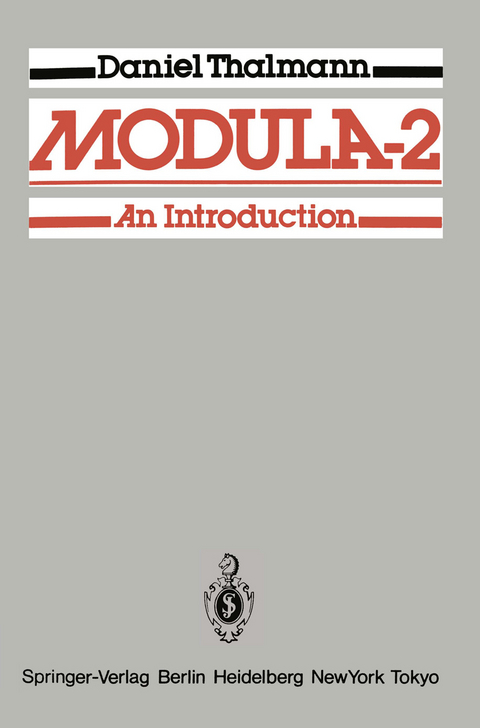
Modula-2
Springer Berlin (Verlag)
978-3-540-13297-4 (ISBN)
1 Introduction.- 1.1 The Role and Origins of Programming.- 1.2 The Evolution of Programming Languages.- 1.3 The "Module"l Concept.- 1.4 Lexical, Syntactic and Semantic Analysis.- 1.5 The MODULA-2 Vocabulary.- 1.6 Syntactic Diagrams.- 1.7 Structure of a MODULA-2 Program.- 1.8 A First Program: How to Write a String.- 1.9 Some Basic Considerations for Writing Programs.- Summary.- 2 Numbers.- 2.1 Integer and Real Numbers.- 2.2 Operators.- 2.3 The MathLibO Module.- 2.4 Arithmetic Expressions.- 2.5 How to Write Numbers.- 2.6 Program Examples.- Summary.- 3 Constants, Variables and Data Typesb.- 3.1 Constants.- 3.2 Variables and Data Types.- 3.3 INTEGER, CARDINAL and REAL Types.- 3.4 The Assignment Statement.- 3.5 Type Conversion.- 3.6 An Example: Exchange of Two Values.- Summary.- 4 The Boolean and CHAR Types.- 4.1 Boolean Constants and Operations.- 4.2 Boolean Expressions.- 4.3 Relational Operators.- 4.4 Two Program Examples.- 4.5 The Type CHAR.- Summary.- 5 Basic Control Statements.- 5.1 The IF Statement.- 5.2 The WHILE Statementb.- 5.3 The REPEAT Statement.- 5.4 Program Examples.- Summary.- 6 The Input/Output Modules.- 6.1 The Role of the Read Operation.- 6.2 Text Input.- 6.3 The InOut and ReallnOut Modules.- 6.4 Program Examples.- Summary.- 7 Enumeration and Subrange Types.- 7.1 Enumeration Types.- 7.2 Order in Enumeration Types.- 7.3 Subrange Types.- 7.4 A Program Example.- Summary.- 8 Other Control Statements.- 8.1 The LOOP Statement.- 8.2 The FOR Statement.- 8.3 The CASE Statement.- 8.4 Program Examples.- Summary.- 9 Array Types.- 9.1 One-Dimensional Arrays.- 9.2 Program Examples.- 9.3 String Types.- 9.4 Program Examples: Palindromes.- 9.5 Multi-Dimensional Arrays.- 9.6 Program Examples.- Summary.- 10 Procedures and Locality.- 10.1 The Procedure Concept.- 10.2Locality.- 10.3 Parameters.- 10.4 A Program Example.- Summary.- 11 Transmission of Parameters and Scope.- 11.1 Variable and Value Parameters.- 11.2 Open Array Parameters.- 11.3 Rules of Scope.- Summary.- 12 Function Procedures and Procedure Types.- 12.1 The Function Procedure Concept.- 12.2 A Complete Example.- 12.3 Procedure Types.- 12.4 A Complete Example.- Summary.- 13 Recursion.- 13.1 The Concept of Recursion.- 13.2 The Towers of Hanoi.- 13.3 Quicksort and Permutations.- 13.4 Indirect Recursion and Recursive Descent.- Summary.- 14 Modules.- 14.1 The Module Concept.- 14.2 Definition Modules.- 14.3 Implementation Modules.- 14.4 Separate Compilation.- 14.5 A Complete Example: The Stack.- Summary.- 15 Local Modules.- 15.1 The Concept of Local Modules.- 15.2 Import/Export Lists.- 15.3 Rules of Scope.- 15.4 Local Modules Defined Side by Side.- 15.5 Modules Defined Local to a Procedure.- 15.6 A Complete Example.- Summary.- 16 Records.- 16.1 RECORDTypes.- 16.2 Manipulation of Records and Fields.- 16.3 The WITH Statement.- 16.4 An Example of Data Abstraction: The Use of Multiple Stacks.- 16.5 Records with Variant Parts.- Summary.- 17 Sets.- 17.1 SET Types and the BITSET Type.- 17.2 Set Constants and Variables.- 17.3 Set Operators.- 17.4 The Standard Procedures INCL and EXCL.- 17.5 An Example of a Module for Processing Bitsets.- Summary.- 18 Streams.- 18.1 The Stream Concept.- 18.2 Access to a Stream Component.- 18.3 Text Streams.- 18.4 A Program Example: Bold Text.- Summary.- 19 Dynamic Data Structures.- 19.1 Pointers.- 19.2 Dynamic Allocation.- 19.3 Lists.- 19.4 A Complete Example of List Processing with a Local Module.- 19.5 Stacks and fifo Queues: Two List Processing Modules.- 19.6 Binary Trees.- Summary.- 20 Processes.- 20.1 Concurrency.- 20.2 Processes.- 20.3 Monitors.- 20.4 Signals.- 20.5 A Classical Example: A Shared Buffer.- Summary.- 21 Low-Level Features.- 21.1 Why Low-Level Programming?.- 21.2 The Type WORD.- 21.3 The Type ADDRESS.- 21.4 Type Transfer Functions.- 21.5 Coroutines.- 21.6 An Application of Coroutines.- 21.7 Dynamic Storage.- 21.8 Device Handling, Interrupts and Fixed Addresses.- 21.9 Low-Level File Operations.- 21.10 Generic Modules.- Summary.- References.- Appendix 1: The Syntax of MODULA-2.- Appendix 2: Keywords and Standard Identifiers.
| Erscheint lt. Verlag | 1.10.1985 |
|---|---|
| Zusatzinfo | XII, 292 p. |
| Verlagsort | Berlin |
| Sprache | englisch |
| Maße | 155 x 235 mm |
| Gewicht | 454 g |
| Themenwelt | Mathematik / Informatik ► Informatik ► Programmiersprachen / -werkzeuge |
| Mathematik / Informatik ► Informatik ► Software Entwicklung | |
| Informatik ► Theorie / Studium ► Compilerbau | |
| Schlagworte | CASE • data structure • data structures • language • MODULA-2 • object-oriented programming (OOP) • PASCAL • Processing • programming • Programming language • Programming language A • Software |
| ISBN-10 | 3-540-13297-X / 354013297X |
| ISBN-13 | 978-3-540-13297-4 / 9783540132974 |
| Zustand | Neuware |
| Informationen gemäß Produktsicherheitsverordnung (GPSR) | |
| Haben Sie eine Frage zum Produkt? |
aus dem Bereich


